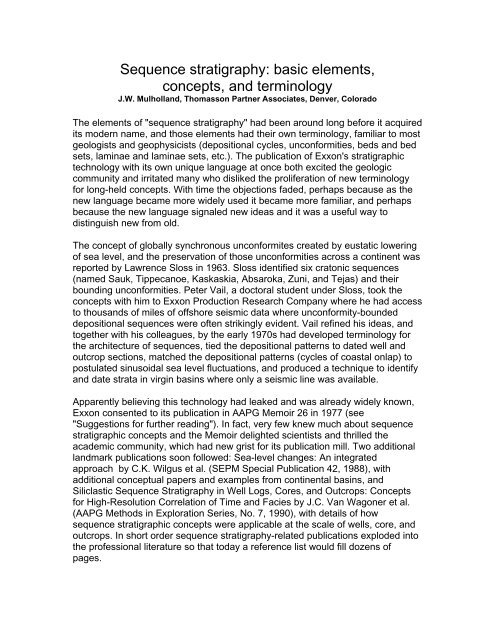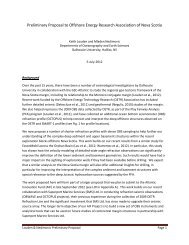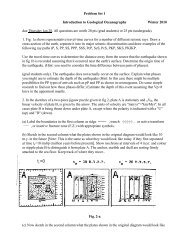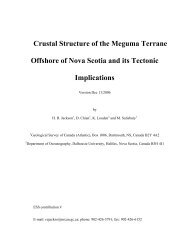Sequence stratigraphy: basic elements,
Sequence stratigraphy: basic elements,
Sequence stratigraphy: basic elements,
You also want an ePaper? Increase the reach of your titles
YUMPU automatically turns print PDFs into web optimized ePapers that Google loves.
<strong>Sequence</strong> <strong>stratigraphy</strong>: <strong>basic</strong> <strong>elements</strong>,<br />
concepts, and terminology<br />
J.W. Mulholland, Thomasson Partner Associates, Denver, Colorado<br />
The <strong>elements</strong> of "sequence <strong>stratigraphy</strong>" had been around long before it acquired<br />
its modern name, and those <strong>elements</strong> had their own terminology, familiar to most<br />
geologists and geophysicists (depositional cycles, unconformities, beds and bed<br />
sets, laminae and laminae sets, etc.). The publication of Exxon's stratigraphic<br />
technology with its own unique language at once both excited the geologic<br />
community and irritated many who disliked the proliferation of new terminology<br />
for long-held concepts. With time the objections faded, perhaps because as the<br />
new language became more widely used it became more familiar, and perhaps<br />
because the new language signaled new ideas and it was a useful way to<br />
distinguish new from old.<br />
The concept of globally synchronous unconformites created by eustatic lowering<br />
of sea level, and the preservation of those unconformities across a continent was<br />
reported by Lawrence Sloss in 1963. Sloss identified six cratonic sequences<br />
(named Sauk, Tippecanoe, Kaskaskia, Absaroka, Zuni, and Tejas) and their<br />
bounding unconformities. Peter Vail, a doctoral student under Sloss, took the<br />
concepts with him to Exxon Production Research Company where he had access<br />
to thousands of miles of offshore seismic data where unconformity-bounded<br />
depositional sequences were often strikingly evident. Vail refined his ideas, and<br />
together with his colleagues, by the early 1970s had developed terminology for<br />
the architecture of sequences, tied the depositional patterns to dated well and<br />
outcrop sections, matched the depositional patterns (cycles of coastal onlap) to<br />
postulated sinusoidal sea level fluctuations, and produced a technique to identify<br />
and date strata in virgin basins where only a seismic line was available.<br />
Apparently believing this technology had leaked and was already widely known,<br />
Exxon consented to its publication in AAPG Memoir 26 in 1977 (see<br />
"Suggestions for further reading"). In fact, very few knew much about sequence<br />
stratigraphic concepts and the Memoir delighted scientists and thrilled the<br />
academic community, which had new grist for its publication mill. Two additional<br />
landmark publications soon followed: Sea-level changes: An integrated<br />
approach by C.K. Wilgus et al. (SEPM Special Publication 42, 1988), with<br />
additional conceptual papers and examples from continental basins, and<br />
Siliclastic <strong>Sequence</strong> Stratigraphy in Well Logs, Cores, and Outcrops: Concepts<br />
for High-Resolution Correlation of Time and Facies by J.C. Van Wagoner et al.<br />
(AAPG Methods in Exploration Series, No. 7, 1990), with details of how<br />
sequence stratigraphic concepts were applicable at the scale of wells, core, and<br />
outcrops. In short order sequence <strong>stratigraphy</strong>-related publications exploded into<br />
the professional literature so that today a reference list would fill dozens of<br />
pages.
One not familiar with sequence <strong>stratigraphy</strong> will ask, "Why is it useful?" The<br />
answer is that it is an unparalleled exploration tool for oil, gas, and coal as well as<br />
a production tool for reservoir development, It works for both elastic and<br />
carbonate systems. For geophysicists it provides techniques for<br />
chronostratigraphic interpretation of seismic lines that provide;<br />
(1) the ability to age-date to at least the period level seismic strata in previously<br />
unexplored basins,(2) more accurate facies identification in unknown strata, (3)<br />
identification of probable source-rock intervals and the location of probable<br />
reservoir facies, and(4) development of both tectonic and sedimentation histories<br />
of new basins or basins where data are sparse or limited in areal extent. For<br />
geologists, as stated by Van Wagoner et al., its application will result in "(1) more<br />
accurate surfaces for mapping and facies correlation, and (2) higher-resolution<br />
chronostratigarphy for improved definition of plays, especially stratigraphic traps."<br />
Continuing to paraphrase Van Wagoner et al., it also will yield a more effective<br />
method for (1) evaluating sandstone continuity, (2) predicting reservoir , source<br />
and sealing facies, (3) projecting reservoir trends into areas with limited data, (4)<br />
identifying stratigraphic traps, and (5) extending the life of older producing fields.<br />
Perhaps the real dividend has been that geologists and geophysicists exposed to<br />
the technique and its results are energized, excited, and infused with new ideas<br />
for tired basins and plays, usually resulting in increased discoveries and addition<br />
of new reserves.<br />
The rest of this paper will review concepts and terminology. Readers are<br />
cautioned that this is a complex topic and this overview is a far from exhaustive<br />
treatment. The cited publications will provide a more in-depth introduction to the<br />
details and theory and lead the reader into consideration of the numerous<br />
published studies now available.<br />
General concepts<br />
H.W. Posamentier et al. (in an article in SEPM Special Publication 42), defined<br />
sequence <strong>stratigraphy</strong> as "the study of rock relationships within a<br />
chronostratigraphic framework wherein the succession of rocks is cyclic and is<br />
composed of genetically related stratal units (sequences and systems tracts)."<br />
Behind this statement lie a number of assumptions and general concepts:<br />
• Marine sedimentation patterns are controlled by changes in relative sea<br />
level.<br />
• Relative sea level is controlled by eustasy, subsidence, tectonics, and<br />
sedimentation rate. On trailing-edge continental shelf environments,<br />
eustasy is of primary importance. In epeiric basins tectonics may<br />
overshadow the role of eustasy. Subsidence and sedimentation rate are<br />
commonly of secondary importance and are commonly assumed to be<br />
processes operating at constant rates (but, of course, they do not).
• Sedimentation patterns controlled by sea level have distinct geometries<br />
(systems tracts) that are easily recognized on seismic lines, well logs, well<br />
log cross sections, outcrops, and cores.<br />
• On passive margin shelves, as these geometries are eustaticallycontrolled,<br />
they are similar worldwide. Once the geometry has been<br />
calibrated in a familiar area, it can be used as a correlation tool to identify<br />
and date seismic strata elsewhere.<br />
• The building blocks of a depositional sequence are laminae and laminae<br />
sets, beds and bed sets, parasequences and parasequence sets, systems<br />
tracts, sequences and sequence sets. <strong>Sequence</strong>s are bounded above and<br />
below by unconformities (also termed sequence boundaries), which record<br />
a fall in relative sea level.<br />
<strong>Sequence</strong> <strong>stratigraphy</strong> may be applied at several scales, and in this sense it is<br />
fractal in nature (meaning that at any scale sequences have the same<br />
characteristics). Phanerozoic history is comprised of first-order eustatic<br />
sequences. First-order sequences are called megasequences by B.U. Haq et al.<br />
(in SEPM Special Publication 42) and are equivalent to the cratonic sequences of<br />
Sloss. Eras are comprised of second-order eustatic sequences (supersequences<br />
of Haq et al.). Seismic <strong>stratigraphy</strong> normally is concerned with third-order<br />
sequences (1-5 MY duration), and it is this level that is the subject of AAPG<br />
Memoir 26. Geologic studies of well log cross sections, outcrops, and cores deal<br />
with third, fourth (10 5 years duration) and fifth-order (10 4 years duration)<br />
sequences, and these are the subject of Van Wagoner et al.<br />
Figure 1. Schematic diagram to illustrate components of a sequence which includes a significant<br />
basal unconforrnity, or sequence boundary (SB). HST= highstand systems tract. TST =<br />
transgressive systems tract. LST = lowstand systems tract. MFS = maximum flooding surface,<br />
also called the condensed section (CS). PS = parasequence. Well log profiles are illustrated by<br />
stylized gamma ray (GR) curves and a resistivity (R) curve.
Terminology<br />
<strong>Sequence</strong> <strong>stratigraphy</strong> has been defined above. Additional terms are quoted<br />
below from Table 1 of Posamentier et al. There is insufficient space in this article<br />
to expound on these terms, which are filled with meaning that can only be fully<br />
understood by study of the <strong>basic</strong> literature suggested at the conclusion of this<br />
article. Future articles in this series will, however, expand on these concepts.<br />
Figure 1 illustrates some of these features.<br />
• "<strong>Sequence</strong>: A relatively conformable succession of genetically related<br />
strata bounded at its top and base by unconformities and their correlative<br />
conformities. it is composed of a succession of systems tracts and is<br />
interpreted to be deposited between eustatic-fall inflection points." Note<br />
that a sequence is terminated by a fall in sea level.<br />
• "Systems tract: A linkage of contemporaneous depositional systems (L.<br />
F. Brown Jr. and W.L. Fisher, in AAPG Memoir 26). Each is defined<br />
objectively by stratal geometries at bounding surfaces, position within the<br />
sequence, and internal parasequence stacking patterns. Each is<br />
interpreted to be associated with a specific segment of the eustatic<br />
curve..."<br />
• "Depositional System: A three-dimensional assemblage of lithofacies,<br />
genetically linked by active (modern or inferred (ancient) processes and<br />
environments (delta, river, barrier island, and so on) (Brown and Fisher.)."<br />
• "Parasequence: A relatively conformable succession of genetically<br />
related beds or bedsets bounded by marine-flooding surfaces or their<br />
correlative surfaces (Van Wagoner, at SEPM's 1985 Midyear Meeting)."<br />
Note that a parasequence is terminated by a rise in sea level.<br />
Parasequences are generally below the resolution of most seismic data,<br />
but their bounding surfaces produce reflections that are time-stratigraphic<br />
seismic events.<br />
• "Unconformity: A surface separating younger from older strata, along<br />
which there is evidence of subaerial erosional truncation (and, in some<br />
areas, correlative submarine erosion) or subaerial exposure, with a<br />
significant hiatus indicated." Unconformities are time-stratigraphic<br />
surfaces, are readily identifiable on seismic lines due to the underlying<br />
truncation and overlying onlap relationships, and are associated with a fall<br />
in relative sea level. Regional unconformities are also called sequence<br />
boundaries.<br />
• "Condensed Section: A thin marine stratigraphic interval characterized by<br />
very slow depositional rates (
• "Accommodation: The space made available for potential sediment<br />
accumulation (M.T. Jervey, SEPM Special Publication 42)."<br />
Growth of a sequence.<br />
<strong>Sequence</strong> <strong>stratigraphy</strong> is necessarily an understanding of geologic processes.<br />
The terminology above gives us tools to describe the processes that produce<br />
sequences and the components of which a sequence is constructed. By going<br />
through the development of a sequence process by process and component by<br />
component (process-response modeling), we gain an understanding of the <strong>basic</strong><br />
model and some insight into the variations possible. The following description is<br />
abbreviated, and readers who seek a better understanding are encouraged to<br />
consult the suggested readings.<br />
<strong>Sequence</strong>s are controlled by changes in relative sea level, and as they are<br />
bounded top and bottom by unconformities, they necessarily begin with a<br />
lowstand of sea level. The lowstand exposes the continental shelf, or in an<br />
epeiric sea, the shallower portions of the sea floor, to subaerial exposure and<br />
erosion (Figure 2). This erosion may be slight or it may include valleys up to<br />
several hundred feet in depth.<br />
Figure 2. <strong>Sequence</strong> boundary formation. (Figures 2-5 are from Siliciclastic <strong>Sequence</strong><br />
Stratigraphy in Well Logs, Cores, and Outcrops: Concepts for High-Resolution Correlation of<br />
Time and Faces by J.C. Van Wagoner, R.M. Mitchum, K.M. Campion, and V.D. Rahmanian, (c)<br />
1990 by AAPG. They are reprinted by permission of the American Association of Petroleum<br />
Geologists and by Datapages, Inc.)<br />
At lowstand (Figure 3), sediment transported down valleys is delivered at the<br />
shoreline to form estuarine and beach environments, or is carried off the shelf<br />
edge into deep water to form sea floor fans or lowstand wedges in the angle<br />
between floor and slope.
Figure 3. Lowstand systems tract (reproduced from Van Wagoner et al.)<br />
As sea level rises, the shoreline transgresses across the erosional surface and<br />
the locus of deposition shifts inland (Figure 4). Because sediment is transported<br />
from land to sea, discrete depositional packages, called parasequences, are<br />
developed. Beach parasequences typically coarsen upward and in the<br />
progradational direction change facies from coastal plain (coal and clay) through<br />
marginal marine (sandstone) to offshore marine (shale). As sea level rises,<br />
successive parasequences are built, but each begins and ends further landward<br />
than the one preceding it. The result is a stack of parasequences having a<br />
"retrogradational stacking pattern," characteristic of the transgressive systems<br />
tract. Valleys normally fill first (the lowstand systems tract), beginning with fluvial<br />
sands, overlain by estuarine or bayhead delta facies, and finally filled to<br />
overflowing with shoreface paraseqeunces (the transgressive systems tract).<br />
Figure 4. Transgressive systems tract (reproduced from Van Wagoner et al.).<br />
As the rate of sea level rise begins to slow, the sediment volume delivered to the<br />
shore is just sufficient to fill the accommodation space, and the parasequences<br />
stop retreating and build upward, creating an "aggradational stacking pattern." As
sea level reaches its highstand, the shelf is now under fairly deep water and is<br />
starved for sediment. A condensed section is deposited, consisting of a thin layer<br />
of black shale composed of mostly pelagic and hemipelagic debris. On seismic<br />
line it appears as a downtap surface, and on well logs it will commonly be a thin<br />
radioactive shale (the "hot shale" marker of many cross sections). The<br />
condensed section, also known as the maximum flooding surface, is an excellent<br />
source rock.<br />
As sea level begins its accelerating downward movement, sediment delivery<br />
outpaces available accommodation, and the streams have to flow farther and<br />
farther seaward to deposit their load (Figure 5). Consequently, the<br />
parasequences thus created migrate seaward, forming "progradational stacking<br />
patterns," characteristic of the highstand systems tract. Offshore, the<br />
accommodation space greatly exceeds the volume of silt and clay being<br />
delivered, and depositional patterns take on downtapping sigmoidal patterns,<br />
thinning and wedging out atop the condensed section.<br />
Figure 5. Highstand systems tract (reproduced from Van Wagoner et al.).<br />
Eventually sea level falls below the base level of the streams at the shore line,<br />
and they begin eroding into their own delta/shoreface deposits. The highstand<br />
systems tract becomes fully exposed as sea level reaches a new lowstand, a<br />
surface of erosion is created, and the upper sequence boundary is in place,<br />
ready to receive the next sequence.<br />
Frequently this ideal cycle is incomplete. Where tectonic effects are prevalent,<br />
the highstand systems tract may never develop, as uplift forces a retreat of the<br />
shoreline and creates a premature upper sequence boundary. Alternatively, uplift<br />
may be sufficiently prolonged that once-complete sequences are truncated<br />
deeply, with removal of most of their highstand systems tract. It is not uncommon<br />
in the Rocky Mountain basins to see stacked lowstand systems tracts without any<br />
evidence of transgressive or highstand systems tracts. it is also possible to<br />
observe sequences with little or no transgressive systems tract development (one<br />
thin parasequence, or the condensed section lying directly on the sequence
oundary), but with a fairly complete highstand systems tract. Variations on the<br />
model, especially at the scale of fourth and fifth order sequences, are many and<br />
interpreters must be sensitive to the possibilities.<br />
Conclusion.<br />
<strong>Sequence</strong> <strong>stratigraphy</strong> has come of age, and it is a tool every explorationist must<br />
master. It is essential for regional and local exploration studies, for seismic<br />
evaluation, and for reservoir evaluation. While carbonate sequence <strong>stratigraphy</strong><br />
has not been emphasized here, it is equally important. (I feel that carbonate<br />
geologists were doing sequence <strong>stratigraphy</strong> well before it became known as<br />
such, because carbonate strata are clearly cyclic and depositional environments<br />
are very sensitive to sea-level fluctuations. The concepts and language of<br />
sequence <strong>stratigraphy</strong>, however, has imposed a more systematic framework to<br />
carbonate <strong>stratigraphy</strong>.)<br />
Future articles in this series will speak in more detail about the <strong>elements</strong> of<br />
sequences, methods of interpretation for geologists and geophysicists age, and<br />
provide applications and examples. To build on one's understanding of<br />
sequences, it is important to thoroughly understand all the <strong>elements</strong> of stratal<br />
architecture. In this light, future articles will focus on sequence architecture<br />
(boundaries, systems tracts, and facies), the parasequence and its <strong>elements</strong><br />
(lamina, beds, boundaries, depositional environments and facies), the condensed<br />
section and bio<strong>stratigraphy</strong>, systems tracts and stacking patterns, sequence<br />
scale (orders, time spans, and causes), tectonism versus eustasy, carbonate<br />
sequence <strong>stratigraphy</strong>, principles of seismic interpretation, principles of log<br />
correlation, core and outcrop interpretation, exploration applications, production<br />
applications, many examples, including some that contrast pre- and<br />
postsequence <strong>stratigraphy</strong> interpretations and the benefit gained by the new<br />
insight, and an overview of some specialized topics such as the value of<br />
sequence <strong>stratigraphy</strong> in coal , lacustrine , and eolian environments,<br />
photo<strong>stratigraphy</strong>, and computer simulation. All these discussions will have the<br />
common themes of process (sedimentary, tectonic, eustatic, erosional), response<br />
(deposition or erosion), and our interpretation (depositional environment, facies<br />
patterns, rock successions, diagenetic response, hydrocarbon habitat).<br />
Suggestions for further reading. Although universally known as AAPG Memoir<br />
26, this breakthrough publication is officially titled Seismic Stratigraphy-<br />
Applications to Hydrocarbon Exploration and was edited by C.E. Payton. Sloss's<br />
fundmental work was archived in "<strong>Sequence</strong>s in the cratonic interior of North<br />
America" (GSA Bulletin, 1963). Vail's own "Seismic <strong>stratigraphy</strong> interpretation<br />
procedure" can be found in the Atlas of Seismic Stratigraphy (AAPG, 1987).









